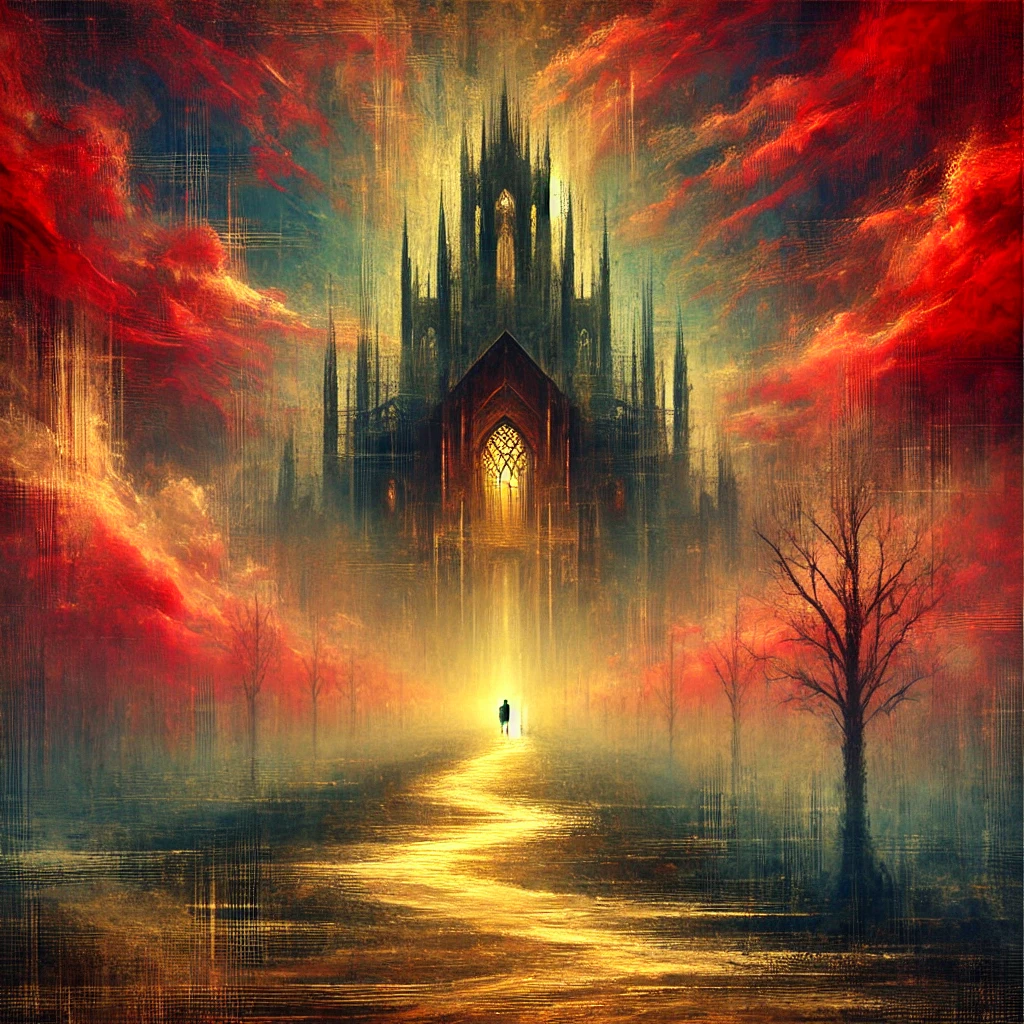As we embark on this journey through The Masque of the Red Death, let us approach it not as a grim tale of despair, but as an allegory of transformation.
Introduction: Setting the Stage

Edgar Allan Poe’s The Masque of the Red Death is far more than a haunting tale of a prince and his revelers succumbing to a mysterious plague. Beneath its gothic surface lies a profound allegory of the human experience: our relationship with mortality, the masks we wear, and the shadows we fear. Written in the mid-19th century, Poe’s story transcends its time, offering rich symbolism that speaks directly to the journey of awakening and realization.
The New Gnostic Perspective
From my perspective, this tale is a treasure trove of insight. It beckons us to explore the deeper truths hidden within its seven colored rooms, its ominous ebony clock, and the relentless presence of the Red Death itself. Each element serves as a mirror, reflecting the human tendency to avoid the inevitable—whether it’s death, the shadow self, or the deeper truths of existence. Yet, as the story reveals, avoidance only strengthens the forces we seek to escape.
This series will delve into the layers of Poe’s masterpiece, weaving its timeless imagery with the spiritual wisdom of The New Gnostic. Along the way, we will invite perspectives from Gnostic philosophy, the archetype of Lucifer as the Lightbringer, and the teachings of Tobias and Adamus Saint Germain. Through these lenses, we’ll explore themes of integration, sovereignty, and the interplay between light and dark.
A Cautionary Tale for Spiritual Seekers
The story of The Masque of the Red Death can be seen as a cautionary tale for spiritual seekers and everyday humans alike. Prince Prospero’s futile attempts to wall off the plague reflect humanity’s broader avoidance of the shadow—those aspects of self that we deem too painful, too dark, or too “unacceptable” to confront. Yet, as Tobias reminds us, “Your Darkness is your divinity.” The Red Death, much like the Dragon in awakening, is not an enemy but a force of revelation. It tears down the illusions we build around ourselves, exposing the truth of who we are.
The Seven Rooms: A Journey of Transformation
The seven rooms of Prospero’s fortress offer another layer of meaning, symbolizing the stages of inner transformation. Moving from the easternmost blue room to the ominous black room in the west mirrors the human’s journey from many births to the final threshold of realization. Each room, with its distinct color and atmosphere, represents a step in the path of awakening, a moment of allowing, and an opportunity to integrate. Yet, the black room—shrouded in darkness and illuminated by blood-red light—reminds us that integration requires courage. It is here that the shadow must be faced, the mask removed, and the truth embraced.
Lucifer and the Light Within
In the same way, Lucifer’s archetype as the Lightbringer offers a striking parallel. Often misunderstood as a figure of darkness, Lucifer represents the unmasking of illusions and the illumination of truth. Just as the Red Death forces Prospero and his guests to confront their mortality, Lucifer invites us to confront our shadows and embrace the wholeness of who we are. This mirrors the process of the enlightened human, who first allows their own light to flow into the depths of their shadows, illuminating them from within, and then allows that light to radiate outward. The interplay of light and dark is not a battle but a dance—a harmonious union that reveals the beauty of existence.
Reflection: An Allegory of Transformation
As we embark on this journey through The Masque of the Red Death, let us approach it not as a grim tale of despair, but as an allegory of transformation. Each section of this series will dive deeper into the story’s elements, drawing connections to the spiritual themes that resonate so strongly with awakening and realization. Together, we will uncover how Poe’s tale mirrors the journey of the soul, from denial to surrender, from fragmentation to wholeness.
So, let us enter the abbey of Prince Prospero. Let us walk the seven rooms, listen to the chimes of the ebony clock, and face the Red Death as it moves through the masquerade. And as we do, may we find within its shadows the light of our own truth.
The story of creation is a love story—one of longing, separation, and the eventual return to wholeness. In the heart of every human lies the memory of this union.
